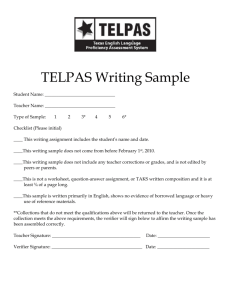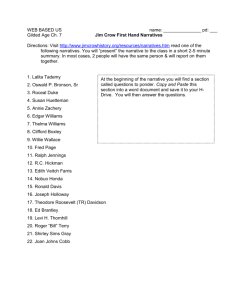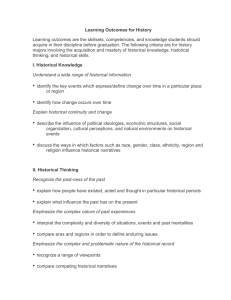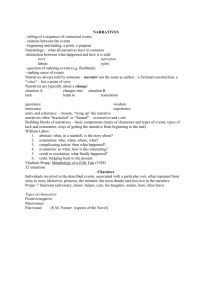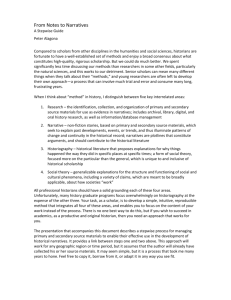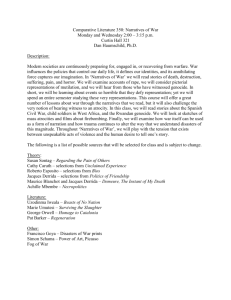ZDM 97/6 Book Reviews Schifter, Deborah (Ed.):
advertisement
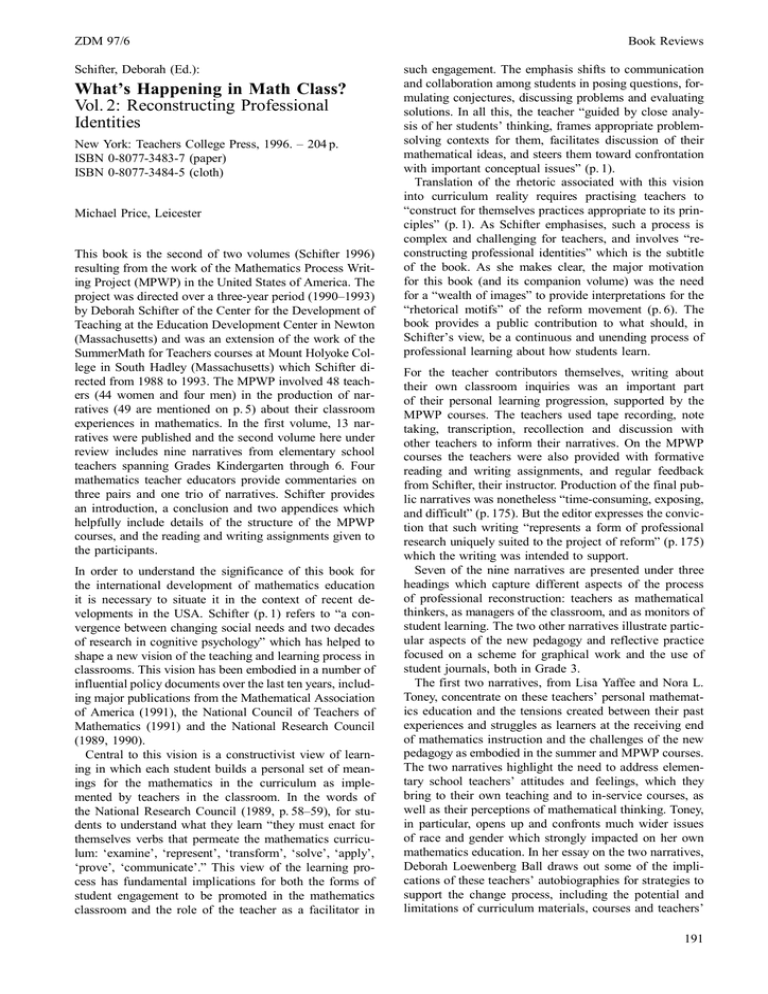
ZDM 97/6 Schifter, Deborah (Ed.): What’s Happening in Math Class? Vol. 2: Reconstructing Professional Identities New York: Teachers College Press, 1996. – 204 p. ISBN 0-8077-3483-7 (paper) ISBN 0-8077-3484-5 (cloth) Michael Price, Leicester This book is the second of two volumes (Schifter 1996) resulting from the work of the Mathematics Process Writing Project (MPWP) in the United States of America. The project was directed over a three-year period (1990–1993) by Deborah Schifter of the Center for the Development of Teaching at the Education Development Center in Newton (Massachusetts) and was an extension of the work of the SummerMath for Teachers courses at Mount Holyoke College in South Hadley (Massachusetts) which Schifter directed from 1988 to 1993. The MPWP involved 48 teachers (44 women and four men) in the production of narratives (49 are mentioned on p. 5) about their classroom experiences in mathematics. In the first volume, 13 narratives were published and the second volume here under review includes nine narratives from elementary school teachers spanning Grades Kindergarten through 6. Four mathematics teacher educators provide commentaries on three pairs and one trio of narratives. Schifter provides an introduction, a conclusion and two appendices which helpfully include details of the structure of the MPWP courses, and the reading and writing assignments given to the participants. In order to understand the significance of this book for the international development of mathematics education it is necessary to situate it in the context of recent developments in the USA. Schifter (p. 1) refers to “a convergence between changing social needs and two decades of research in cognitive psychology” which has helped to shape a new vision of the teaching and learning process in classrooms. This vision has been embodied in a number of influential policy documents over the last ten years, including major publications from the Mathematical Association of America (1991), the National Council of Teachers of Mathematics (1991) and the National Research Council (1989, 1990). Central to this vision is a constructivist view of learning in which each student builds a personal set of meanings for the mathematics in the curriculum as implemented by teachers in the classroom. In the words of the National Research Council (1989, p. 58–59), for students to understand what they learn “they must enact for themselves verbs that permeate the mathematics curriculum: ‘examine’, ‘represent’, ‘transform’, ‘solve’, ‘apply’, ‘prove’, ‘communicate’.” This view of the learning process has fundamental implications for both the forms of student engagement to be promoted in the mathematics classroom and the role of the teacher as a facilitator in Book Reviews such engagement. The emphasis shifts to communication and collaboration among students in posing questions, formulating conjectures, discussing problems and evaluating solutions. In all this, the teacher “guided by close analysis of her students’ thinking, frames appropriate problemsolving contexts for them, facilitates discussion of their mathematical ideas, and steers them toward confrontation with important conceptual issues” (p. 1). Translation of the rhetoric associated with this vision into curriculum reality requires practising teachers to “construct for themselves practices appropriate to its principles” (p. 1). As Schifter emphasises, such a process is complex and challenging for teachers, and involves “reconstructing professional identities” which is the subtitle of the book. As she makes clear, the major motivation for this book (and its companion volume) was the need for a “wealth of images” to provide interpretations for the “rhetorical motifs” of the reform movement (p. 6). The book provides a public contribution to what should, in Schifter’s view, be a continuous and unending process of professional learning about how students learn. For the teacher contributors themselves, writing about their own classroom inquiries was an important part of their personal learning progression, supported by the MPWP courses. The teachers used tape recording, note taking, transcription, recollection and discussion with other teachers to inform their narratives. On the MPWP courses the teachers were also provided with formative reading and writing assignments, and regular feedback from Schifter, their instructor. Production of the final public narratives was nonetheless “time-consuming, exposing, and difficult” (p. 175). But the editor expresses the conviction that such writing “represents a form of professional research uniquely suited to the project of reform” (p. 175) which the writing was intended to support. Seven of the nine narratives are presented under three headings which capture different aspects of the process of professional reconstruction: teachers as mathematical thinkers, as managers of the classroom, and as monitors of student learning. The two other narratives illustrate particular aspects of the new pedagogy and reflective practice focused on a scheme for graphical work and the use of student journals, both in Grade 3. The first two narratives, from Lisa Yaffee and Nora L. Toney, concentrate on these teachers’ personal mathematics education and the tensions created between their past experiences and struggles as learners at the receiving end of mathematics instruction and the challenges of the new pedagogy as embodied in the summer and MPWP courses. The two narratives highlight the need to address elementary school teachers’ attitudes and feelings, which they bring to their own teaching and to in-service courses, as well as their perceptions of mathematical thinking. Toney, in particular, opens up and confronts much wider issues of race and gender which strongly impacted on her own mathematics education. In her essay on the two narratives, Deborah Loewenberg Ball draws out some of the implications of these teachers’ autobiographies for strategies to support the change process, including the potential and limitations of curriculum materials, courses and teachers’ 191 Book Reviews writing. These two narratives shed little light on these teachers’ own classroom practices but, as Ball concludes, “it is crucial in designing supports for their learning that teachers’ stories be heard; their experiences, respected; and their views, solicited” (p. 44). The two narratives from Karen Schweitzer and Anne Marie O’Reilly illustrate features of the new patterns of authority involved in the new pedagogy. As Schifter points out, “figuring out how to translate the vision into dayto-day instruction ... will be neither smooth nor rapid, but arduous, sometimes scary, and sometimes exhilarating” (p. 46). Schweitzer’s narrative brings her own classroom to life through lively description, samples of dialogue, and analysis of her Grade 2 students’ responses to a range of challenging tasks involving practical counting, grouping and measurement. The excitement, disappointment, confusion and frustration involved in giving these young students a large measure of choice and control are well exemplified, and Schweitzer’s growing confidence, supported by the MPWP course, is evident. By contrast, O’Reilly’s narrative is strong on self-reflection in relation to the rhetoric for reform but she only provides one episode from her Grade 6 classroom. Ruth M. Heaton’s essay on the two narratives emphasises the importance of these teachers’ feelings about the new patterns of authority in their classrooms, and the value of honest and reflective accounts to support other teachers in the process of change. In particular she focuses on promoting classroom discourse and the risks involved, including how to cope with silence. The three narratives from Janice M. Szymaszek, Christine D. Anderson and Jessica Dobie Redman illustrate the process of inquiry into students’ mathematical conceptions through classroom practice, guided by watching and listening to the students in order to unpack their own lines of thinking. The linking essay is provided by Stephen Lerman who is quick to point out that “interpreting what students know from what they say is far from straightforward” (p. 126). Szymaszek and Redman provide rich accounts of a wide range of counting activities for Kindergarten and Grade 2 students respectively. The element of surprise in students’ responses and thinking is strong in both narratives, and the tasks were well chosen to push the students’ thinking to their limits, with the teachers “leading from behind” (p. 96). Szymaszek’s judgement that her experience was “glorious and bewildering” (p. 96) is well substantiated in her account. Redman makes a significant confession: “Realizing that there were such different levels of understanding of counting frightened me” (p. 119). Anderson focuses on shape identification in the Kindergarten. The element of surprise is again strong, notably in relation to the concepts of side and triangle as exemplified in different practical contexts. The challenge to draw and talk about drawing a shape, line by line, also proved to be particularly productive. Lerman’s essay focuses on the extent to which these three narratives move from classroom observation, through inquiry into students’ mathematical conceptions, to promote the notion of “teacher as researcher” (p. 131). The strength of these particular narratives certainly supports this challenging notion. 192 ZDM 97/6 The final two narratives are provided by Grade 3 teachers, Valerie Penniman and Deborah Carey O’Brien. Penniman presents a detailed description and analysis of her ambitious scheme for graphical work. She also steps back to evaluate its success in terms of a number of aspects of her own decision making about the students’ role in the learning process: the degree of challenge, the level of security, and the extent of students’ self analysis, decision making and ownership of the mathematics. O’Brien discusses the use of journals both as a tool for students’ learning and as a form of teacher assessment, including feedback to parents. Her narrative clearly demonstrates the steepness of the learning curve involved for both the teacher and her students in making effective use of such a tool. Susan Jo Russell’s essay highlights the challenge of reflective practice for the busy and vulnerable classroom practitioner: “Taking responsibility for the teaching of mathematics means examining the complexity of the students’ knowledge, beliefs, and experience to try to make good guesses about their views of mathematical ideas, rather than blaming them for being unable or unwilling to learn.” (p. 158) She concludes that reflective teaching, as exemplified by the last two narratives, is “a matter of taking ‘two steps forward, one step back’, in a continual cycle of experimentation, observation, reflection, and revision” (p. 161). In the conclusion, Schifter steps back from the set of narratives to situate them in the context of national priorities for curriculum development in the USA: “Stories like those collected here must become public; their telling, commonplace. For the kind of transformation teachers are being asked to undertake is so profound, the challenges to their professional ways of being so threatening, that without some larger perspective that contextualizes their difficulties, and without the reassuring knowledge that others have worked through similar confusions, most will despair of success when the going gets rough, and many once again will retreat behind the closed doors of the classroom.” (p. 164) As an English reviewer I am struck by the extent to which such priorities for mathematics curriculum development in the USA are no longer matched by those prevailing in England in the late 1990s. Classroom teachers’ reflections and writing about English students’ learning have largely been eroded since the 1980s by external political pressures both for accountability, through the National Curriculum, tests and inspection, and for more emphasis on effective methods of instruction to achieve better results in national and international performance tables, based on pencil-andpaper tests. I welcome this book, which puts the learners at the centre of the classroom enterprise. The contributions have been well prepared, organised and edited, and I would value further collections along similar lines. But I regret that such a book is unlikely to be produced in English conditions up to the next millennium. The notion of “teachers leading from behind” would not appeal to English politicians (including the new Labour government), and the subtleties and complexities of such a notion would largely be lost on the public at large, who represent the consumers ZDM 97/6 Book Reviews in education. The significance of the book under review is largely determined by the national context within which it was created. References Mathematical Association of America (1991): A call for change: Recommendations for the mathematical preparation of teachers. – Washington, DC: MAA National Council of Teachers of Mathematics (1991): Professional standards for teaching mathematics. – Reston, VA: NCTM National Research Council (1989): Everybody counts: A report to the nation on the future of mathematics education. – Washington, DC: National Academy Press National Research Council (1990): Reshaping school mathematics: A framework for curriculum. – Washington, DC: National Academy Press Schifter, D. (Ed.) (1996): What’s happening in math class? Vol. 1: Envisioning new practices through teacher narratives. – New York: Teachers College Press Author Price, Michael H., Dr., University of Leicester, School of Education, 21 University Road, Leicester LE1 7RF, England. mhp3@leicester.ac.uk 193
